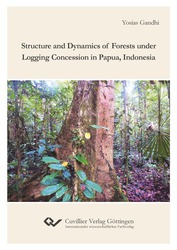| Fachbereiche | |
|---|---|
| Buchreihen (96) |
1378
|
| Nachhaltigkeit |
3
|
| Gesundheitswesen |
1
|
| Geisteswissenschaften |
2363
|
| Naturwissenschaften |
5406
|
| Mathematik | 229 |
| Informatik | 319 |
| Physik | 980 |
| Chemie | 1363 |
| Geowissenschaften | 131 |
| Humanmedizin | 243 |
| Zahn-, Mund- und Kieferheilkunde | 10 |
| Veterinärmedizin | 108 |
| Pharmazie | 147 |
| Biologie | 835 |
| Biochemie, Molekularbiologie, Gentechnologie | 121 |
| Biophysik | 25 |
| Ernährungs- und Haushaltswissenschaften | 45 |
| Land- und Agrarwissenschaften | 1004 |
| Forstwissenschaften | 201 |
| Gartenbauwissenschaft | 20 |
| Umweltforschung, Ökologie und Landespflege | 148 |
| Ingenieurwissenschaften |
1791
|
| Allgemein |
98
|
|
Leitlinien Unfallchirurgie
5. Auflage bestellen |
|
Erweiterte Suche
Structure and Dynamics of Forests under Logging Concession in Papua, Indonesia
Yosias Gandhi (Autor)Vorschau
Leseprobe, PDF (160 KB)
Inhaltsverzeichnis, PDF (120 KB)
The sexiest lowland forests in Papua Indonesia, hosting many high-valued timber species, attract the country’s authorities to allocate 94% as production forests. The main aim is to manage the forests sustainably under a concessionaire system strongly requiring sustainable-sense protocols stated in the national silviculture system-TPTI. However, in many cases, the logging activities in the tropics fail to perform sustainability in production and ecological integrity due to unavoidable high harvesting intensity adopted in uniform cutting protocols. Therefore, comprehending an intact forest’s local-specific features helps develop an adaptable silviculture technique. The book elaborates on 143 species identified in two logging concessions of Papua and explains significant differences in the distinct primary forests formed by the species. It also reveals the individuals and species of commercial timbers left after logging. Furthermore, it presentably discusses the current logging impacts potentially changing the species’ relative abundance, downgrading the future degree of tree diversity and causing a massive timber volume reduction that fizzles out to enter the third cycle. Additionally, the state-of-the-art method of relating species’ slope structure with its sapwood content of δ15N and N is conceptually explained to classify 103 species by light-requirement trait. Therefore, it is a critical indicator for species selection in the enrichment planting of pre-grown seedlings and subsequent tending. Ultimately, including a combination of species-specific minimum cutting diameter in TPTI with the consequence of enlarging the concession area becomes the ambitious goal of this work.
| ISBN-13 (Printausgabe) | 9783736976344 |
| ISBN-13 (E-Book) | 9783736966345 |
| Buchendformat | A5 |
| Sprache | Englisch |
| Seitenanzahl | 248 |
| Umschlagkaschierung | glänzend |
| Auflage | 1. |
| Erscheinungsort | Göttingen |
| Promotionsort | Göttingen |
| Erscheinungsdatum | 22.06.2022 |
| Allgemeine Einordnung | Dissertation |
| Fachbereiche |
Forstwissenschaften
|
| Schlagwörter | Abholzungsaktivitäten, abgeholzte Wälder, Abundanz, Basalfläche, Baumartenzusammensetzung, Baumdichte, Baumdurchmessergrößen, Baumhäufigkeit, Baumkronenbestand, Chapman-Richards-Wachstumsfunktion, Diversität, Durchmesserklassen, Ernteintensität, gemischte Nutzhölzer, Gesamt-N, Handelshölzer, Heterogenität, hochwertige Nutzhölzer, Holzeinschlag-Konzession, Indonesien, indonesische Waldbausystem, intakte Wälder, Lichtanforderungen, Mindestschnittdurchmesser, natürliche Verjüngung, N-Isotopenverhältnis, opportunistisch, Papua, Produktionswälder, Regeneration, schattentolerant, Schössling, Setzling, Shannon Index, Simpson Index, Struktur, Tropenwälder, Walddegradation, Waldkronen, Xylemgewebe, deforestation activities, deforested forests, abundance, basal area, tree species composition, tree density, tree diameter sizes, tree abundance, canopy cover, Chapman-Richards growth function, diversity, diameter classes, harvest intensity, mixed commercial timber, total N, commercial timber, heterogeneity, high-value commercial timber, logging concession, Indonesia, Indonesian silvicultural system, intact forests, light requirements, minimum cutting diameter, anpassungsfähigen Waldbautechnik, adaptable silviculture technique, natural regeneration, N isotope ratio, opportunistic, Papua, production forests, regeneration, shade tolerant, sapling, Shannon Index, Simpson Index, structure, tropical forests, forest degradation, forest canopy, xylem fabric |
| URL zu externer Homepage | https://www.perpusnas.go.id/?lang=en |








